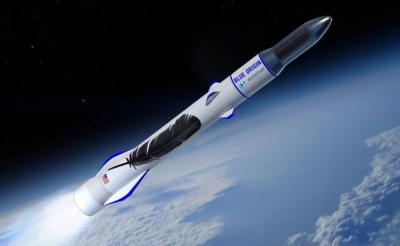Mon, Nov 17, 2025
New Glenn Follows in the Footsteps of SpaceX’s Starship Mega-Rocket
Blue Origin finally logged a clean booster recovery with New Glenn, giving Jeff Bezos’ company something it has been publicly chasing for years: proof that its heavy-lift rocket can reuse components the same way SpaceX has since October 2024. The flight also shipped two NASA satellites towards Mars as New Glenn’s first paying-customer science payload.

The launch marked an impressive step forward in the long catch-up effort for New Glenn. The program has burned billions of dollars and endured years of delays despite only debuting in January… if that attempt even counts. During the trial, the booster failed to reignite its engines and self-destructed on impact.
The more recent launch lifted off from Cape Canaveral under clear skies after several days of weather delays and a geomagnetic storm. Seven BE-4 engines pushed the vehicle off the pad before the first stage separated and flew itself back toward an autonomous barge in the Atlantic. Roughly ten minutes after liftoff, the 17-story booster touched down without incident.
“We achieved full mission success today, and I am so proud of the team,” said Dave Limp, CEO of Blue Origin. “It turns out Never Tell Me The Odds had perfect odds—never before in history has a booster this large nailed the landing on the second try. This is just the beginning as we rapidly scale our flight cadence and continue delivering for our customers.”

During its short airtime, the mission delivered NASA’s twin EscaPADE spacecraft, Blue and Gold. The two probes will spend the next 22 months cruising toward Mars before entering synchronized orbits to study solar wind interactions with the planet’s weak magnetic field. Their instruments, supplied by UC Berkeley and integrated by Rocket Lab, will examine how solar particles strip away Mars’ already thin atmosphere. NASA paid about $18 million for the ride.
Booster catches aren’t the only SpaceX accomplishment that Blue Origin has replicated, though it’s definitely more exciting than the alternative: destructive endings. SpaceX has experienced more than its fair share of this outcome, with five of Starship’s eleven launch attempts having fiery conclusions. One of the launches didn’t even make it off the pad before exploding. With that being said, however, SpaceX remains overwhelmingly ahead of the curve… and considering its global reputation and immense government partnerships, competitors like Blue Origin will find it increasingly difficult to make up ground.
More News
Marker Beacon An electronic navigation facility transmitting a 75 MHz vertical fan or boneshaped radiation pattern. Marker beacons are identified by their modulation frequency and >[...]
“Aviation is an incredible tool for Samaritan’s Purse. After a disaster strikes, we want people to know why we are bringing life-saving supplies. We want them to know t>[...]
From 2024 (YouTube Edition): New Capabilities For Business Aviation CiES Corporation President Scott Philiben walked Aero-News Editor in Chief Jim Campbell through some of what set>[...]
Also: Duffy Predicts ‘Mass Chaos’, Modern Skies Coalition, More Impacts, Archer Buys Hawthorne With only a few months of preparation—and minimal outside media sup>[...]
The Experienced Pilot Chose To Operate In Instrument Meteorological Conditions Without An Instrument Flight Rules Clearance Analysis: The airplane was operated on a personal cross->[...]
 ANN's Daily Aero-Term (11.14.25): Marker Beacon
ANN's Daily Aero-Term (11.14.25): Marker Beacon Aero-News: Quote of the Day (11.14.25)
Aero-News: Quote of the Day (11.14.25) Classic Aero-TV: CiES All-Digital Fuel Senders
Classic Aero-TV: CiES All-Digital Fuel Senders Airborne 11.10.25: Affordable Expo Succeeds, Citation Ascend, Kenai Shuts Down
Airborne 11.10.25: Affordable Expo Succeeds, Citation Ascend, Kenai Shuts Down NTSB Final Report: Lancair 320
NTSB Final Report: Lancair 320




